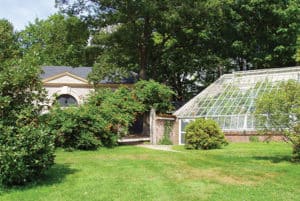By Nadie VanZandt
Gardeners in cold climates have learned to extend the growing season by building greenhouses. As early as 30 A. D., reports of greenhouses appeared in the writings of the famous Pliny the Elder, Roman savant and scientific authority of his time.

One of the oldest U.S. greenhouses is the Lyman Estate Greenhouses in Waltham, Massachu- setts, built in 1798. Here is a view of its carriage house and a greenhouse.
Pliny described specularia as garden beds fitted with wheels that were covered with glazed frames to protect plants in cold weather. In Latin, specularium refers to a transparency that allows light into a building. The word is derived from Lapis specularis, a variety of gypsum rock that splits into sheets almost as clear as glass. Today it is known as selenite.
Specularia were erected on the island of Capri around 30 A.D., specifically to provide a year-round supply of melons (Cucumis melo) for the powerful Emperor Tiberius Caesar.
Although glass had been discovered long before, it only was used to make beads and small vials until 100 A.D. when the Romans began manufacturing glass windows. Masters at glass blowing, they refined a technique to split a long balloon of molten glass into two halves, which they flattened into separate windowpanes.
The Middle Ages were fraught with wars and turmoil. It was not until much later — a millennium later — at the beginning of the Renaissance that Italians developed the concept of modern greenhouses.
Innovation was driven by collections of exotic plants acquired from explorers returning from voyages to faraway lands. The Italian called their greenhouses Giardini botanici, botanical gardens in Italian. They erected them to shelter these exotic plants and study their medicinal properties.
With the Age of Exploration, the Roman concept of greenhouses spread east. In 1459, a cookbook authored by Jeon Soon, a Korean royal physician, describes greenhouses fitted with temperature control features, improving the Italian design with artificial heat and ventilation.
During the 16th Century, greenhouses caught on in the Netherlands, England and France. There, royal courts housed large collections of exotic plants acquired from the explorers that they sponsored.
The structures, a symbol of wealth and prestige, were imposing, luxurious glass and stone monuments built for the pleasure of monarchs while serving as places for scientific study in herbal medicine.
The greenhouse on the grounds of the Palace of Versailles is just one lavish example. The expansively glazed building, commissioned by Louis XIV, is almost 500 feet long and 50 feet high. The high price of glass and the cost of maintaining the optimal climate inside made these structures accessible to only the upper class, governments and scientific institutions.
However, rapid advances in technology during the Industrial Revolution led to manufacturing and design improvements that lowered the cost of glass and reduced taxes on glass and windows. As a result, greenhouses became affordable to middle-class plant enthusiasts.
Similarly in the United States, the high price of glass made the ownership of greenhouses a privilege only afforded by the upper class. The 1798 Federal Direct Tax Law, a property tax repealed in 1847, accounted for the number and size of windows and taxed accordingly, allowing only the wealthiest to be able to afford a greenhouse.
During early years of the republic, some of America’s most famous greenhouses were built by wealthy families with connections in international trade. One of the oldest is the Lyman Estate Greenhouses in Waltham, Massachusetts, built in 1798 for Theodore Lyman, a Boston shipping magnate and avid horticulturist.
The Lyman Estate Greenhouses are still in operation and contain many exotic specimens acquired by Lyman himself. They are open to the public, and admission is free.
Today, materials and construction techniques continue to improve, making greenhouses accessible to all budgets. Plastic films and fiberglass offer new glazing options. Framing materials include aluminum and galvanized steel. More efficient climate control systems are available from passive solar designs to sophisticated heating, air conditioning and ventilation systems.
Many affordable options for greenhouses are available to homeowners. They come in various shapes and sizes. Now is the time to plan if you are considering a greenhouse to shelter your seedlings before the last frost.
Nadie VanZandt is an extension master gardener at the University of Vermont.




